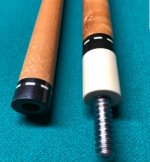Yup. Great looking. Not a Joss (most likely). Joss-like in some regards...but similar to other makers as well.
But that is a 3/8x10 pin, which Stroud "invented"...really had made by accident.
Makes me think that it is somehow in that neighborhood of makers. Maybe. Of course, the pin rapidly became popular and quite ubiquitous so it's hard to say it identifies the cue. It is interesting how the pin is installed...and this is a "good cue". With effort there is a decent chance of nailing down the maker.
I can see why it gets immediate attention.
One thing about Joss...it has frequently said they are all marked. But there are a few early cues that were not. I have no idea if any of them were 3/8x10 but I am thinking not....could easily be wrong.
Great cue. Would love to see it identified but I don't know what it is.
I had one of their first dozen cues, ivory countersunk joint with a big chromed pin
